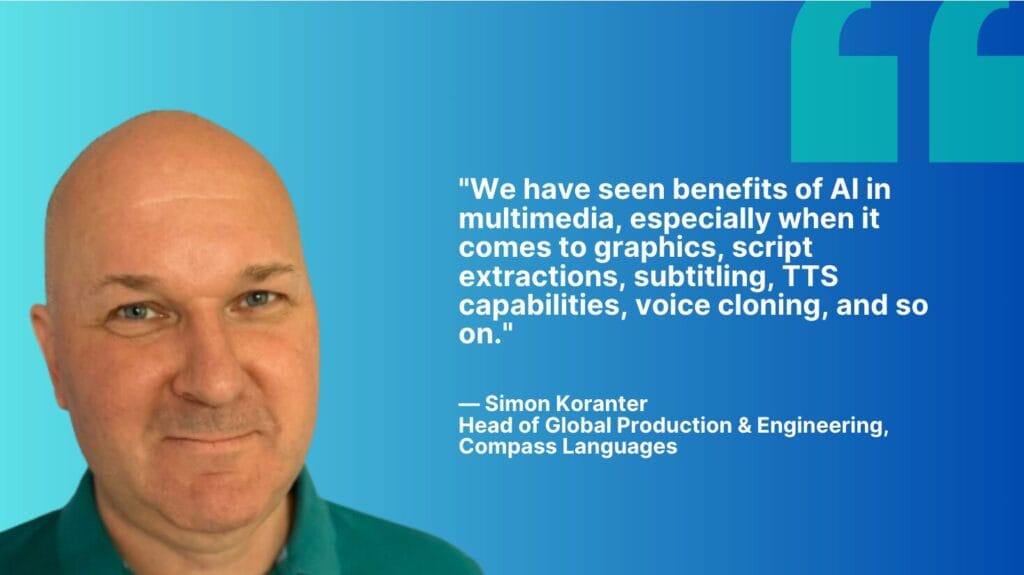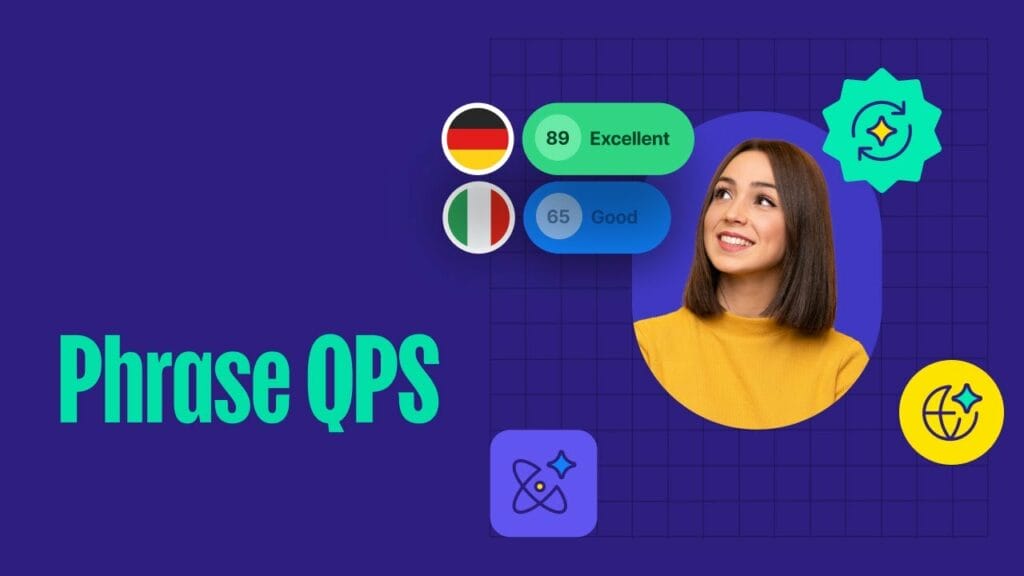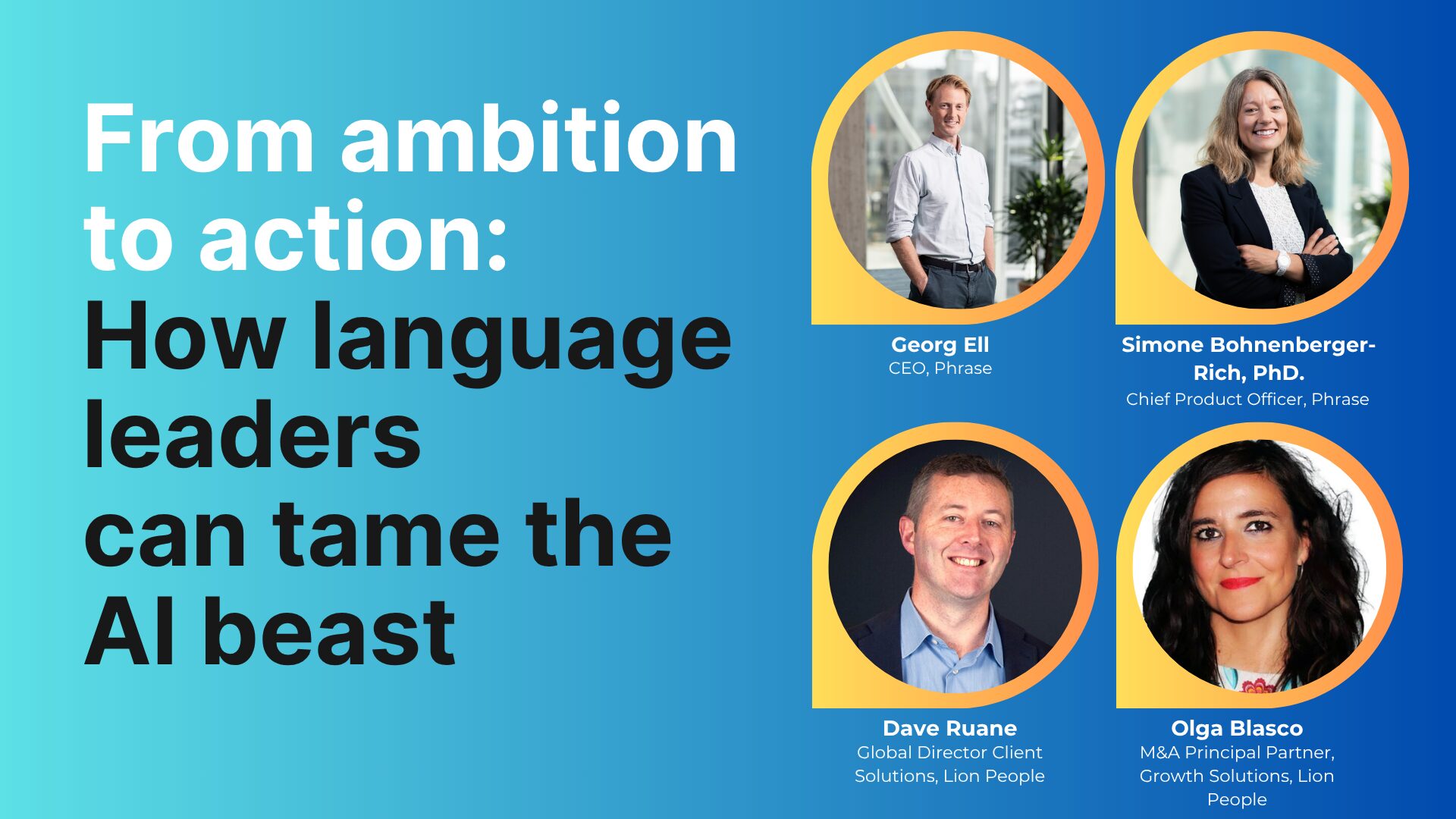Turning GenAI into ROI: How AI is elevating localization from cost center to growth driver
This week, Phrase joined localization experts from around the world at the latest Slatorcon remote conference to explore one of the industry’s most pressing topics: How Generative AI (GenAI) is transforming localization from a back-office function into a strategic business driver.
With AI evolving rapidly, businesses are quickly moving beyond “just” using AI to translate content. They are looking for ways to employ AI to personalize engagement, streamline workflows, and accelerate market expansion.
But how do companies move beyond experimentation and ensure AI-powered localization delivers real business impact?
This was the focus of our panel,“Turning GenAI into ROI: Transforming Localization from a Cost Center to a Strategic Growth Driver,”.
Moderated by Slator’s Head of Research, Anna Wyndham. Phrase’s Chief Product Officer Simone Bohnenberger-Rich joined Simon Koranter, Head of Global Production & Engineering at Compass Languages, and sportswear brand On’s Localization Program Manager Matteo Nonne.
In this post, I’ve gathered the biggest takeaways and strategies from this fascinating discussion, looking at ways AI is reshaping localization strategies, the challenges businesses face in managing expectations, and what’s next for AI-driven content adaptation and multilingual engagement.
“I think LLMs are possibly a once-in-a-lifetime opportunity for localization teams to move much closer to that revenue-generating story.”
— Simone Bohnenberger-Rich, Phrase
From translation to a growth engine
For years, localization has been viewed as a cost center—a necessary operational function rather than a strategic business driver. GenAI is changing that by allowing businesses to scale faster, personalize engagement, and adapt content for diverse audiences.
Instead of just making content available in multiple languages, AI-powered localization allows companies to adjust messaging dynamically based on cultural and market-specific needs.
- AI enables hyper-personalization and transcreation, allowing brands to generate content that feels native to different audiences.
- AI is transforming multimedia localization, making it easier to adapt videos, voice content, and graphics for global markets.
- AI is improving accessibility by generating alt text, captions, and other features that enhance usability for all audiences.
“One of the most promising use cases we see that really moves localization teams more into that pole position of revenue generation is really around what I’ve described earlier—adaptation and transcreation. At Phrase we sometimes call it hyper-personalization.”
— Simone Bohnenberger-Rich, Phrase

“One quick win is something that’s often left behind and forgotten about, which is alt text. AI can generate descriptive content of images that’s picked up by screen readers for visually impaired users, fostering accessibility.”
— Matteo Nonne, On
Managing expectations around AI
While AI is a powerful tool, there are still misconceptions about what it can (and cannot) do. Many companies initially believed that AI could fully automate localization with little to no human oversight.
“On one hand, we had clients who were really, maybe even over excited about the opportunity, about the possibility and potentials of Gen AI, because they all of a sudden thought, well, this is great. I’m gonna press a button and all my worries will go away. Everything will be done in a flash!
– Simon Koranter, Compass Languages
On the other hand, we had clients who were looking at this with a bit of fear in their eyes thinking this is sort of like a Skynet-type scenario.”
AI does not replace human expertise. Instead, it acts as a tool that enhances the capabilities of localization teams.
“If you want to tap into that customization, you do need to go through your own data. That data source—the golden source of truth—is the translation memory.”
— Simone Bohnenberger-Rich, Phrase
The panel agreed that to make AI a long-term success, businesses need to:
- Establish clear expectations about what AI can and cannot do
- Invest in training AI with high-quality data
- Implement a hybrid approach where AI and human expertise work together
What C-level executives prioritize when evaluating AI-driven localization
For AI-powered localization to gain full buy-in from senior leadership, companies must measure its impact in ways that align with business objectives.
Different industries have different priorities when it comes to AI adoption.
- In finance and cryptocurrency, time-to-market is critical. Delays in multilingual content updates can mean financial losses.
- In retail and ecommerce, AI is helping brands manage localization costs while improving content personalization.
- In SaaS and digital products, AI-driven localization supports engagement and retention by adapting interfaces and content dynamically.
“We know with [Phrase] Quality Performance Score (QPS) and intelligent routing, some of our customers see a 50 to 70% reduction in human review effort, and that clearly hits the bottom line.”
— Simone Bohnenberger-Rich, Phrase
Simone stressed the need for localization teams to communicate value by:
- Connecting localization metrics to revenue impact, not just cost savings
- Highlighting AI’s role in improving engagement and customer retention
- Demonstrating efficiency gains in content production and deployment
What’s next for AI in localization
The panel also identified four major shifts and focus areas that are set to shape the next phase of AI-powered localization.
AI-powered quality control
AI is becoming a critical tool for content validation, ensuring brand consistency, accuracy, and fluency before content is published.

Multilingual content creation from the start
Instead of starting with English and translating later, brands will begin producing content in multiple languages at the same time.
“We will start seeing content created in multiple languages at the same time, making global market expansion far more seamless.”
— Matteo Nonne, On
Smarter AI workflows and automation
AI will enable more intelligent automation of localization workflows, but accuracy remains a challenge.
“Agentic workflows are terribly fickle. If an agent has to make three decision points and gets every one 80% right, you overall have a 51% accuracy rate, and that’s pretty much a coin toss.”
— Simone Bohnenberger-Rich, Phrase
The rise of AI data governance
AI-driven localization is only as good as the data it relies on. Companies must prioritize structured, high-quality data to get better AI outputs.
“Localization teams sit on a treasure trove of data. That data is key to personalization and must be leveraged properly to maximize AI’s impact.”
— Simone Bohnenberger-Rich, Phrase
Conclusion
While the majority of businesses are still in an experimental period, it became clear that AI is driving a huge shift in localization, from an operational necessity to a strategic business function. Companies that once viewed localization purely as a cost center are now seeing it as a driver of engagement, retention, and market expansion. Fortunately, localization professionals are well-placed to spearhead this movement and elevate the entire function’s profile.
“Localization teams need to carve out a remit and assert their role as revenue drivers, not just cost centers.”
— Simone Bohnenberger-Rich, Phrase
For businesses looking to stay competitive, AI-powered localization must be approached with a clear strategy. This means:
- Treating localization as a growth function rather than an efficiency tool
- Using AI to personalize content and accelerate market expansion
- Investing in AI data governance to ensure reliable and high-quality outputs
Companies that embrace AI strategically—balancing automation with human expertise—will be best positioned to succeed in global markets, and localization professionals are set to take a wider and more valuable role in the coming months.
Join our events
Join us at one of our in person events in see first-hand how we’re transforming customer experiences and driving international growth.








